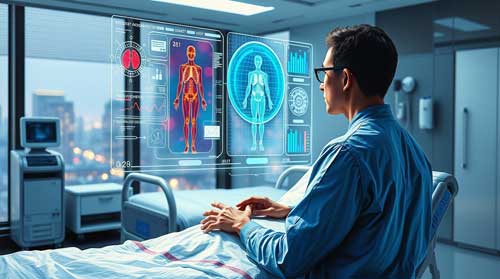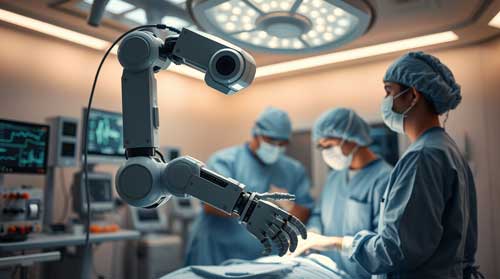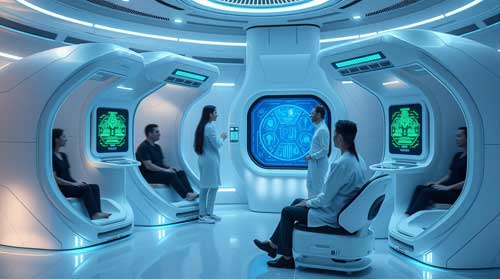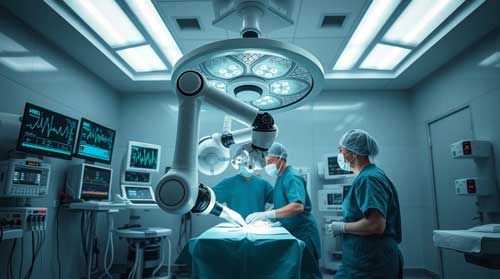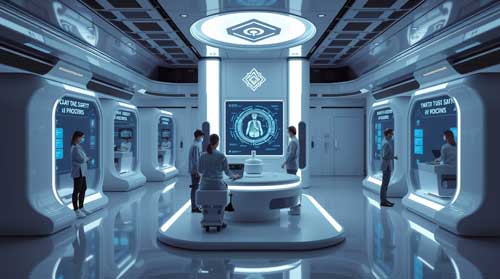Why Artificial Intelligence in Healthcare Is Rewriting Medical Diagnosis in 2025
Please like and subscribe if you enjoyed this video 🙂
Introduction
McKinsey reports that AI in healthcare could save up to $360 billion yearly in U.S. healthcare costs. This remarkable potential extends far beyond cost savings, as AI demonstrates capabilities that match or exceed human experts in specific diagnostic tasks.
The role of AI in healthcare spans across multiple critical areas. AI systems analyze complex medical images, including X-rays, CT scans, and MRIs, with exceptional precision and speed, drastically reducing misdiagnosis risks. Additionally, these advanced technologies process vast amounts of medical data, from patient histories to lab results, enabling healthcare providers to make evidence-based decisions at the point of care. Through continuous monitoring of patient data, AI provides real-time alerts for potential medical conditions, allowing doctors to intervene proactively and develop personalized treatment strategies based on individual patient characteristics.
The Evolution of AI in Medical Diagnosis
AI made its first medical breakthrough in 1971 with INTERNIST-1, a trailblazing artificial medical consultant that used search algorithms to diagnose patients based on their symptoms. The National Institutes of Health recognized AI’s potential and sponsored the first AI in Medicine conference at Rutgers University.
From Traditional to AI-Enhanced Diagnostics
Medical diagnostics has evolved considerably over multiple decades. MYCIN emerged in the 1970s as a groundbreaking system that helped physicians prescribe antibiotics for infectious diseases. The 1980s brought DXplain at the University of Massachusetts, a program that supported clinicians with medical diagnosis. IBM’s Watson system marked the modern AI era in the early 2000s. Watson showed its capabilities by determining RNA binding proteins linked to amyotrophic lateral sclerosis by 2017.
Several core technologies drive AI in medical diagnosis:
Machine Learning (ML) algorithms that analyze electronic health records and reveal trends. Convolutional Neural Networks (CNNs) for hierarchical data interpretation. Natural Language Processing (NLP) for processing clinical notes. Deep Learning systems for complex pattern recognition.
These technologies excel at analyzing vast amounts of medical data, primarily through their ability to process multiple data sources simultaneously. Computer-Aided Detection (CAD) has become fundamental in assisting clinicians, reducing missed diagnoses during imaging studies.
Current State of AI Diagnostic Tools:
Modern AI diagnostic tools show remarkable capabilities in medical specialties of all types. AI algorithms display high sensitivity and specificity when interpreting medical images in radiology. Autonomous pathology detection systems now interpret MRI and ultrasound scans as well as practicing physicians. A South Korean study revealed AI-based diagnosis achieved 90% sensitivity in detecting breast cancer with mass, outperforming radiologists who achieved 78%. AI also performed better at early breast cancer detection with 91% accuracy compared to radiologists at 74%.
Deep learning algorithms accurately diagnose melanoma cases in dermatology, while AI interprets echocardiograms to detect arrhythmias and heart failure in cardiology. ML systems have advanced clinical microbiology greatly by detecting, identifying, and measuring microorganisms.
Transforming Clinical Decision Making:
AI-powered clinical decision support systems are transforming medical practice by improving diagnostic precision and simplifying processes. Traditional methods lead to misdiagnosis in 5-15% of patients. This highlights why we need better diagnostic tools.
Integration with Existing Workflows:
Healthcare facilities need to carefully integrate AI into their clinical workflows. The process requires smooth integration between AI algorithms and electronic health records, imaging systems, and practice management software. Success depends on synchronization with picture archiving and communications systems (PACS) and workflow orchestration software that prioritizes critical cases.
AI integration has brought dramatic benefits to medical centers. A medical center’s radiologists used six AI algorithms to diagnose and triage imaging studies. They focused on detecting pulmonary embolisms, intracranial hemorrhages, and cervical fractures.
Real-time Diagnostic Support:
AI-powered Clinical Decision Support Systems (CDSS) work better than traditional tools by providing immediate help during patient care. These systems analyze several data sources. Medical imaging (2D/3D). Bio-signals (ECG, EEG, EMG). Vital signs. Demographic information. Laboratory results.
The technology demonstrates remarkable capabilities in analyzing medical images, with nearly 400 FDA-approved AI algorithms specifically for radiology. Essentially, these systems process vast amounts of healthcare data with unprecedented speed and accuracy.
Reducing Medical Errors:
AI systems help minimize medical errors through various approaches. Machine learning algorithms enable CDSS to analyze patient data and make predictions that support diagnosis and treatment planning. Diagnostic errors affect 5% of the population each year. In spite of that, AI-driven systems tackle this challenge through early detection and quick clinical alerts.
AI implementation has improved diagnostic accuracy substantially.
AI-based diagnosis achieved 90% sensitivity in breast cancer detection, which surpassed radiologists’ 78%. Natural Language Processing helps AI systems extract valuable information from unstructured clinical notes. This creates a detailed understanding of patient conditions.
AI technology advances have cut decision-making time. This enables earlier interventions and optimizes healthcare delivery. AI systems monitor and analyze data continuously to identify high-risk patients. This allows targeted interventions and better resource allocation.
Precision Medicine and AI Technology.
AI-powered precision medicine is changing healthcare delivery. This new approach uses large datasets to create individual treatment plans. The National Research Council defines this field as developing a new taxonomy of human disease based on molecular biology.
Personalized Diagnostic Approaches:
AI systems learn about patients through multiple data sources to create tailored diagnostic strategies. These platforms look at a patient’s genomics and biomarkers, clinical records, medical history, and environmental factors. They also consider social and behavioral factors along with real-time health monitoring data.
AI algorithms have shown remarkable accuracy in creating personalized diagnoses. Cancer detection systems that use AI reached a 93% match rate with expert tumor board recommendations. These tools help healthcare providers make decisions based on each patient’s unique characteristics rather than using generic solutions.
Genetic Analysis and Disease Prediction:
AI and genomic analysis meet to boost disease prediction capabilities. Healthcare providers can now spot genetic variations that affect treatment responses and disease susceptibility. AI algorithms process huge amounts of genomic data quickly. This speed helps identify rare genetic variants and their possible effects on patient care.
AI analysis of hundreds of exomes in medulloblastoma cases has identified specific molecular subgroups. This discovery allows doctors to administer precise treatment doses. AI tools have also proved reliable when they analyze drug screening data to determine how well compounds work against specific genetic targets.
Treatment Response Optimization
AI systems reshape treatment optimization through real-time analysis of patient responses. The technology has showed great success in predicting how well medications work. This success reduces adverse reactions and leads to better treatment outcomes.
The IDentif.AI platform works with experimental validation to find unexpected drug interactions and create better combination therapies. This method has made treatments 6.5 times more effective by discovering previously unknown drug interactions.
AI algorithms also track treatment outcomes and patient responses in real time. This tracking allows doctors to fine-tune treatment plans continuously. Machine learning helps predict chemotherapy responses with over 80% accuracy for multiple drugs. On top of that, it helps reduce hospital readmissions and emergency department visits through early intervention strategies.
Democratizing Medical Diagnosis.
AI-powered digital health technologies eliminate healthcare disparities across the globe. These advancements promote universal health coverage and enhance patient well-being through sophisticated information and communication systems.
Increasing Healthcare Accessibility:
Modern healthcare systems rely heavily on flexible sensing technologies. These lightweight, adaptable devices deliver more accurate data and let us monitor health continuously. We used their integration with AI to make a marked leap forward in personal health management, especially where resources are limited.
The Healthcare Access and Quality Index showed positive growth from 1990 to 2019. AI-enabled diagnostic tools help people get reliable health insights, whatever their location. Without doubt, this progress brings special value to healthcare deserts, where 121 million Americans live without enough access to primary care providers, pharmacies, hospitals, and community health centers.
Remote Diagnostic Capabilities:
AI-driven telemedicine has become the life-blood of remote healthcare delivery. This technology lets patients access services from home while healthcare professionals track vital signs and step in quickly when needed. People in remote areas can now use AI-powered platforms to: Consult with physicians. Get accurate diagnoses. Get treatment plans. Access specialized care they couldn’t before in their region.
AI algorithms analyze vital signs and patient-reported information to spot potential issues during patient monitoring. These systems send live alerts that help healthcare providers step in remotely and adjust care plans as needed.
Cost Reduction Through AI
AI’s effect on healthcare costs proves substantial. AI-powered healthcare solutions can cut annual costs by $200-$360 billion. These savings come through several channels:
AI automation handles 45% of administrative tasks, saving $150 billion yearly. Supply chain optimization and demand forecasting help AI cut trade operation costs by 34%. AI in medical diagnosis improves health outcomes by 40% and reduces treatment costs by 50%.
Patient wait times have dropped by 30% thanks to this technology’s efficiency. Critical diagnoses will happen faster soon, speeding up access to needed treatments. AI’s role in healthcare keeps growing, with physician adoption rates climbing from 85% in 2016 to 93% in 2022.
Challenges and Limitations
Medical AI has made remarkable progress, yet notable obstacles still block its widespread adoption. Healthcare data has grown at an explosive rate that challenges human ability to process and protect it.
Data Privacy Concerns
Healthcare organizations handle massive amounts of patient data, and protecting this sensitive information remains their biggest problem. Recent studies show healthcare data breaches are increasing in many jurisdictions because of sophisticated algorithmic systems. New computational strategies have shown alarming capabilities: They can re-identify 85.6% of adults in physical activity studies. They link 60% of ancestry data to specific individuals. They connect anonymous health records to actual people through linkage attacks.
Modern algorithms can now bypass traditional privacy safeguards, despite efforts to anonymize data. Large tech companies now dominate technological innovation, which creates an imbalance where public institutions depend more on private sector partnerships.
Regulatory Framework.
AI-based diagnostic tools have become essential to healthcare delivery, and the regulatory landscape continues to evolve. The Food and Drug Administration has created specific approaches for Software as Medical Device (SaMD), but current laws don’t protect individual health data well enough.
The EU AI Act of 2024 introduced an ambitious risk framework, but it lacks provisions for AI liability. The United States uses HIPAA to set data privacy standards, though its scope doesn’t fully cover modern AI applications.
Cross-border data sharing makes regulatory challenges more complex. Laws governing personal health information vary between jurisdictions, which creates potential security gaps. The lack of centralized protocols for data encryption and sharing puts patient privacy at risk.
Integration Barriers
Healthcare frameworks face multiple obstacles in implementing AI systems. Modern AI-DDS (Diagnostic Decision Support) tools are sophisticated, but issues with their development, interoperability, and maintenance raise concerns. Medical providers don’t fully trust or adopt these systems because some AI systems operate as ‘black boxes,’ creating liability challenges.
Key integration barriers include: Technical systems that don’t work with current health information platforms. Major infrastructure changes needed for implementation. Medical professionals who lack proper training and expertise.
A recent survey reveals that only 11% of American adults would share their health data with tech companies, while 72% prefer sharing with their doctors. Only 31% trust tech companies to keep their data secure.
AI systems trained on biased datasets can worsen existing health disparities. These biases often come from training data that focuses too much on certain socio-economic groups and leaves out marginalized populations.
Future of AI-Powered Diagnostics
AI is transforming medical diagnostics and reshaping traditional healthcare approaches. Recent studies show that AI in healthcare will reach 10.15 billion by 2033, signaling a major change in medical practice.
Emerging Technologies.
AI diagnostic tools now come with sophisticated multimodal capabilities. These advanced systems can process different types of data at once, from medical imaging to genomic information. Healthcare organizations currently use several breakthrough technologies.
MedImageInsight for sophisticated image analysis across radiology, pathology, and dermatology. MedImageParse for precise image segmentation across imaging types. CXRReportGen for structured reporting from chest x-rays.
These technologies show remarkable results on standard measurements, with a focus on improving diagnostic accuracy and reducing turnaround times.
Potential Applications.
AI applications in medical diagnostics keep expanding their reach. AI systems now help select patients for promising clinical trials and develop remote health-monitoring devices. The technology excels at detecting hidden conditions and predicting disease risks years ahead.
AI-powered diagnostic tools show great promise in several key areas. These systems can spot early signs of patient deterioration. One hospital reduced serious adverse events by 35% and cardiac arrests by 86%. AI solutions can highlight important areas on scans, which allows instant interpretation in underserved regions.
AI integration with existing healthcare infrastructure creates new ways to improve patient care. These systems will make possible.
Connected care through passive sensors and ambient intelligence. Automated administrative tasks through natural language processing. Remote monitoring of sleep, breathing, and behavior patterns.
Industry Predictions
Market analysis shows substantial growth ahead for AI in medical diagnostics. The global AI diagnostics market, valued at 1.40 billion in 2024, shows remarkable growth potential. Healthcare organizations are adopting AI technologies more rapidly, with physician adoption rates rising from 85% in 2016 to 93% in 2022.
Experts believe AI will become essential for physician decision-making. The next 5 to 10 years will see powerful algorithms that need less data to train and can combine different structured and unstructured data. These developments will create more efficient systems that can use unlabeled data and combine various information sources.
Beyond 10 years, AI systems will become more intelligent, enabling precision medicine through AI-supported healthcare and connected care. This progress will move healthcare away from one-size-fits-all approaches toward preventative, personalized, informed disease management models.
These advanced systems need certain conditions to work well. Healthcare organizations must focus on data standards and resilient infrastructure that aids algorithm retraining, performance testing, and adaptability. Health system leaders should work with researchers and policymakers to link detailed encounter data with long-term outcomes.
The financial outlook seems promising. AI tools in healthcare could save between 200 to 360 billion annually. These cost reductions come from better efficiency in administrative tasks and improved diagnostic accuracy. AI-enabled predictive software needs interoperable data across health systems to build diverse patient health profiles.
[Link]

Conclusion
Artificial intelligence stands as a cornerstone of modern medical diagnosis, reshaping healthcare delivery through enhanced precision and accessibility. Medical facilities worldwide report substantial improvements, with AI systems achieving diagnostic accuracy rates surpassing 90% across multiple specialties. These technological advances generate annual savings between $200 to 360 billion while reducing patient wait times by 30%.
The marriage of AI with precision medicine creates tailored diagnostic approaches, analyzing vast datasets spanning genomics, clinical records, and real-time health monitoring. Healthcare providers now deliver personalized treatment strategies with unprecedented accuracy, supported by AI algorithms that process complex medical data within seconds.
Nevertheless, several hurdles remain. Data privacy concerns, regulatory challenges, and integration barriers require careful consideration as healthcare organizations navigate this technological transformation. The successful implementation of AI diagnostic tools depends on robust security measures, standardized protocols, and comprehensive training programs.
Looking ahead, market projections indicate explosive growth, with the AI diagnostics sector expected to reach $10.15 billion by 2033. Emerging technologies promise enhanced capabilities through multimodal analysis, automated reporting, and sophisticated pattern recognition. These advancements signal a fundamental shift toward preventative, data-driven healthcare models that prioritize early intervention and personalized treatment strategies.
The convergence of AI and medical diagnosis marks a pivotal moment in healthcare history. Through continued innovation and careful attention to ethical considerations, AI-powered diagnostic tools will play an essential role in building a more efficient, accessible, and patient-centered healthcare system.

